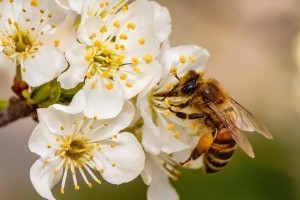 Wild bees will be most attracted to a garden space that mimics their natural habitat and provides an abundance of food. Interplant local varieties that flower at different times throughout the year to ensure a continuous nectar supply for bees and other pollinators.
Wild bees will be most attracted to a garden space that mimics their natural habitat and provides an abundance of food. Interplant local varieties that flower at different times throughout the year to ensure a continuous nectar supply for bees and other pollinators.
Opt for natural alternatives to chemical sprays when applying pesticides or fertilizers. Bees and other pollinators are extremely sensitive, and chemical applications can disrupt and even decimate entire populations.
When choosing which flowers to plant, keep in mind that bees are receptive to fragrance as well as colors in the ultraviolet range, so fragrant blooms in hues of blues, purples, and yellows are more likely to attract their attention. An intentionally cultivated and well-rounded bee habitat might include the following: crocus (late winter/early spring blooms), salvia (late spring/early summer blooms), cosmos (summer blooms), echinacea (mid-summer/early fall blooms), goldenrod (fall blooms), and winter-blooming heather (winter blooms).
Blooming trees are another fantastic way to provide a large and extremely fragrant supply of nectar for bees if you live in a favorable climate, citrus trees are especially fragrant and great at attracting bees to your garden.
Source: https://fruitgrowers.com/6-fun-facts-about-growing-and-harvesting/
Add your voice! Click below to comment. ThriftyFun is powered by your wisdom!